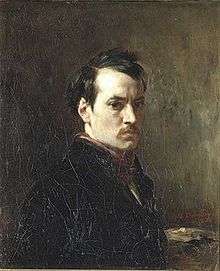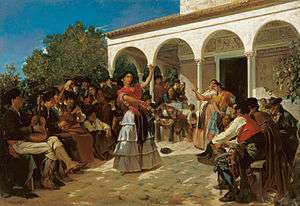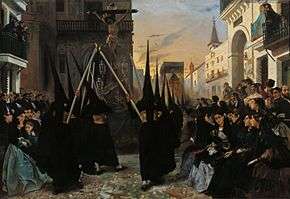Alfred Dehodencq
| Alfred Dehodencq | |
|---|---|
 Self portrait, 1848 | |
| Born |
Edmé-Alexis-Alfred Dehodencq April 23, 1822 Paris, France |
| Died |
January 2, 1882 (aged 59) Paris |
| Nationality | French |
| Known for | Painting |
| Awards | Legion of Honour |
Alfred Dehodencq (birth name Edmé-Alexis-Alfred Dehodencq ) (23 April 1822 – 2 January 1882) was a mid-19th-century French Orientalist painter born in Paris. He was known for his vivid oil paintings, especially of Andalusian and North African scenes.
Life
Dehodencq was born in Paris on 23 April 1822. During his early years, Dehodencq studied in Paris at the Ecole des Beaux Arts under the tutelage of French artist Leon Cogniet. During the French Revolution of 1848 he was wounded in the arm and was sent to convalesce in the Pyrenees before moving to Madrid.[1] He spent five years in Spain where he became acquainted with the works of Spanish painters Diego Velázquez and Francisco Goya which had a strong influence on his approach to painting.

In 1853 he travelled to Morocco, where for the following ten years he produced many of his most famous paintings depicting scenes of the world he encountered. Dehodencq was the first foreign artist known to have lived in Morocco for an extended number of years.
While he considered himself to be a 'Last of the Romantics', his work is generally categorized with the mid-19th-century Orientalist artistic movement.
Dehodencq married Maria Amelia Calderon in 1857 in Cadiz, Spain, and they had three children. Their son, painter Edmond Dehodencq,[2] was born in Cadiz in 1860 (and died in Paris in 1887). Dehodencq returned to Paris in 1863 with his wife, and was decorated with the Legion of Honour in 1870. He committed suicide on 2 January 1882[3] having been sick for a long time and is buried in the Montmartre Cemetery.
Inspired by the life and death of Sol Hachuel, Dehodencq painted Execution of a Moroccan Jewess (1860), which is among his better-known paintings. This painting along with his studio was destroyed by an angry mob.[4] His painting A Jewish Woman with her Negro Maid (1867) as well as over 30 of his drawings are in the collection of the Israel Museum, Jerusalem.
Selected Works
- Bullfight in Madrid, 1850, Musée des Beaux-Arts de Pau[5]

- Jewish concert at the palace of the Moroccan Qaid, 1854, special collection
- The justice of the Pasha, 1866, Musée Salies, Bagnères-de-Bigorre
- Jewish bride in Morocco, 1867, Musée Saint-Denis, Reims
- Farewell of Boabdil in Granada, 1869, Musée d'Orsay, Paris
- Jewish celebration in Tanger, 1870, Musée de Poitiers[6]
- Portrait of Mrs. Dehodencq, Musée Magnin, Dijon
- Prince Piscicelli, 1850, Musée des Beaux-Arts de Bordeaux
- Portrait de Marie au nœud rouge, 1872, special collection
- A Confraternity in Procession along Calle Génova, Carmen Thyssen Museum, Málaga
- A Gypsy Dance in the Gardens of the Alcázar, in front of Charles V Pavilion 1851, Carmen Thyssen Museum, Málaga
- Gypsies on the road, Musée d'Orsay, Paris
- Jewish bride, Palais des Beaux-Arts de Lille
- Danse of negroes in Tanger, 1874, Musée d'Orsay, Paris
- Jesus raises the daughter of Jairus, Musée Magnin, Dijon
- Paris cafe scene, National Gallery, Washington, D.C.
- Little gypsy, Baltimore Museum of Art, Baltimore
References
- ↑ Edmé-Alexis-Alfred Dehodencq (French, 1822-1882), Christopher Columbus at the Monastery of Rabida at Christie's
- ↑ Musées Midi-Pyrénées Edmond Dehodencq
- ↑ Gérard-Georges Lemaire: Orientalismus. Das Bild des Morgenlandes in der Malerei. Könemann, Köln 2000, ISBN 3-8331-1433-9, p.338.
- ↑ Alfred Dehodencq : l'homme & l'artiste: Séailles, Gabriel, P114-115
- ↑ Françoise Cachin, Charles S. Moffett, Juliet Wilson Bareau, « Manet 1832–1883 », Réunion des Musées Nationaux, Paris,1983. ISBN 2-7118-0230-2. p.237.
- ↑ Exhibited at Salon de Paris in 1870
External links
 Media related to Alfred Dehodencq at Wikimedia Commons
Media related to Alfred Dehodencq at Wikimedia Commons